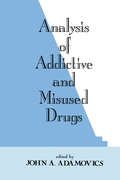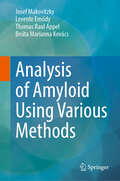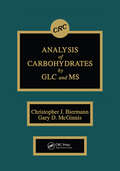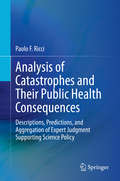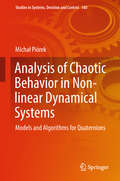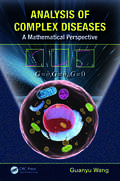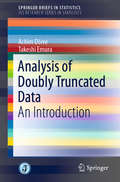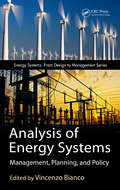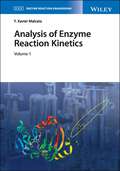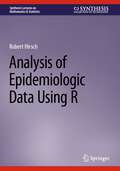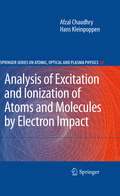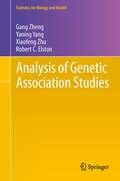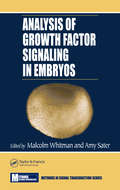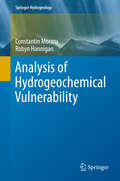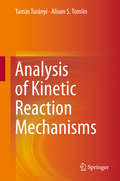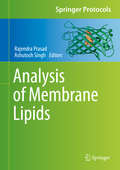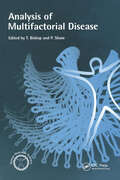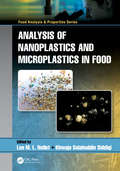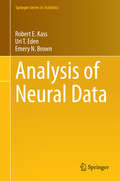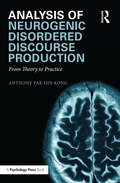- Table View
- List View
Analysis of Addictive and Misused Drugs
by John A. AdamovicsExamines the chromatographic and nonchromatographic methods available to identify, measure, and screen for nonmedical drug use, highlighting the latest technologies in immunochemical analysis, biosensors, thinlayer gas chromatography, high-performance liquid chromatography, and capillary electrophoresis. A comprehensive alphabetic listing of over 400 controlled-use drugs is provided.
Analysis of Airborne Particles by Physical Methods
by Malissa HannsFirst Published in 2018. Routledge is an imprint of Taylor & Francis, an Informa company.
Analysis of Amyloid Using Various Methods
by Josef Makovitzky Levente Emődy Thomas Raul Appel Beáta Marianna KovácsThis book explores the world of amyloid, consisting of heterogeneous deposits that have captivated scientists for decades. Amyloid, characterized by its highly organized insoluble protein fibrils exhibiting cross-layered quaternary beta-sheet structures, comprises diverse components such as the P-component, sialic acid, O-acyl sialic acid, and sGAG components. This assembly forms an anisotropic entity that induces birefringence in linearly polarized light, creating a distinctive optical signature. Initially linked to human disease and tissue damage, the predominant idea that amyloid only harms the host has been challenged. Recent pioneering studies have uncovered the existence of functional amyloid fibers in unexpected domains, from bacteria to mammals. Advances during the 1960s and 1970s, along with seminal immunohistochemical investigations, gave impetus to immunobiological analysis of amyloid in the 1980s. Notable work, such as the exploration of amyloid fiber staining techniques and the comprehensive study of histochemical properties, have enriched the understanding of this enigmatic deposit. The book presents a current overview of amyloid research in health and disease, with contributions from the prestigious biennial Amyloid Forum. Written by a distinguished researcher with nearly five decades of experience, the book encompasses five meticulously elaborated chapters. From human and animal deposits to bacterial formations, isolated fibrils, prions, and amyloid-related neurodegenerative disorders, each category of deposit is given a thorough examination. Innovative topo-optical staining techniques - polarization microscopy, fluorescence microscopy and confocal laser scanning fluorescence microscopy - reveal intricate structures in all species. Coherent structural features are authenticated by various staining reactions and different digestions. A key segment dissects animal prion fibers, revealing their intricate architecture by topo-optical reactions and uncovering selective arrangements of components. To complete this, the book confirms the postulated helical structure of the amyloid fiber. This innovative idea is validated by laser scanning confocal fluorescence microscopy, which reveals ordered and helically stacked amyloid protein fibrils in β-sheet conformation. Associations with chondroitin, heparan sulfate, and looser sphingolipid linkages further unravel the structural complexities of amyloid. Also offers an insightful journey into the realm of amyloid, combining historical knowledge with cutting-edge methodologies, redefining the understanding of this intricate phenomenon.
Analysis of Boolean Functions
by Ryan O'DonnellBoolean functions are perhaps the most basic objects of study in theoretical computer science. They also arise in other areas of mathematics, including combinatorics, statistical physics, and mathematical social choice. The field of analysis of Boolean functions seeks to understand them via their Fourier transform and other analytic methods. This text gives a thorough overview of the field, beginning with the most basic definitions and proceeding to advanced topics such as hypercontractivity and isoperimetry. Each chapter includes a "highlight application" such as Arrow's theorem from economics, the Goldreich-Levin algorithm from cryptography/learning theory, Håstad's NP-hardness of approximation results, and "sharp threshold" theorems for random graph properties. The book includes roughly 450 exercises and can be used as the basis of a one-semester graduate course. It should appeal to advanced undergraduates, graduate students, and researchers in computer science theory and related mathematical fields.
Analysis of Carbohydrates by GLC and MS
by Christopher J. Biermann Gary D. McGinnisThis textbook is a comprehensive guide to analysis of carbohy-drates by gas-liquid chromatography and mass spectrometry. In addition to explaining the facets of carbohydrate analysis and their relation to each other, the text also contains in-depth reference in-formation useful to practitioners in the field. Improvements in car-bohydrate analyses methodology during the past six years are also highlighted. This extensively illustrated text provides excellent data for those in carbohydrate, agriculture, and food chemistry.
Analysis of Catastrophes and Their Public Health Consequences: Descriptions, Predictions, and Aggregation of Expert Judgment Supporting Science Policy
by Paolo F. RicciPublic health policy prospectively and retrospectively addresses the consequences of events ranging from the commonplace to the catastrophic. Informing policymakers and stakeholders by enhancing their understanding of complex causation to justify remedial or precautionary actions is a critical science-policy task. In this book, the key aspects of catastrophes (regardless of their nature) and routine events are identified through a common framework for their analyses, and the analyses of the consequences associated with the potential occurrence of these events also are discussed. The book is not about disaster planning; instead, it is focused on analysis and causation in the context of informing – rather than formulating – public health policy. The author aggregates and fuses scientific information and knowledge in public health policy-science using alternative but complementary methods. The book first focuses on the analysis of catastrophes and commonplace events; the focus then shifts to causal models of multifactorial diseases, particularly at low doses or dose-rates, associated with these events. Topics explored among the chapters include:Policy and Legal Aspects of Precautionary ChoicesCatastrophes, Disasters, and Calamities: Concepts for Their Assessment Uncertainty: Probabilistic and Statistical AspectsAggregating Judgments to Inform Precautionary Decision-makingThe aim of the book is to show that the analyses of events are fundamentally similar, regardless of whether the concern is a global catastrophe or commonplace. Analysis of Catastrophes and Their Public Health Consequences is a text that should engage students, instructors, and researchers in public health, science policy, and preparedness research, as well as serve as a useful resource for policy analysts, practitioners, and risk managers.
Analysis of Chaotic Behavior in Non-linear Dynamical Systems: Models and Algorithms for Quaternions (Studies in Systems, Decision and Control #160)
by Michał PiórekThis book presents a new approach for the analysis of chaotic behavior in non-linear dynamical systems, in which output can be represented in quaternion parametrization. It offers a new family of methods for the analysis of chaos in the quaternion domain along with extensive numerical experiments performed on human motion data and artificial data. All methods and algorithms are designed to allow detection of deterministic chaos behavior in quaternion data representing the rotation of a body in 3D space. This book is an excellent reference for engineers, researchers, and postgraduate students conducting research on human gait analysis, healthcare informatics, dynamical systems with deterministic chaos or time series analysis.
Analysis of Chemical Warfare Degradation Products
by Joseph A. Caruso Renee N. Easter Stuart A. Willison Douglas D. Richardson Karolin K. KroeningThis book describes nerve agents and vesicants, their decomposition and their degradation products' chemistry as well as their toxicity including a list of detection techniques of nerve agents and their degradation products. This book will present their history, toxicity, comparison between different sample preparation methods, separation techniques, and detection methods all together in a short, easy to read book, tied together by a single group doing the writing and the editing to assure smooth transition from chapter to chapter, with sufficient Tables and literature references for the reader who looks to further detail.The text will illustrate the pluses and minuses of the various techniques with sufficient references for the reader to obtain extensive detail.
Analysis of Complex Diseases: A Mathematical Perspective
by PhD, Guanyu WangA complex disease involves many etiological and risk factors operating at multiple levels-molecular, cellular, organismal, and environmental. The incidence of such diseases as cancer, obesity, and diabetes are increasing in occurrence, urging us to think fundamentally and use a broader perspective to identify their connection and revolutionize trea
Analysis of Data from Randomized Controlled Trials: A Practical Guide
by Jos W.R. TwiskThis book provides a practical guide to the analysis of data from randomized controlled trials (RCT). It gives an answer to the question of how to estimate the intervention effect in an appropriate way. This problem is examined for different RCT designs, such as RCTs with one follow-up measurement, RCTs with more than one follow-up measurement, cluster RCTs, cross-over trials, stepped wedge trials, and N-of-1 trials. The statistical methods are explained in a non-mathematical way and are illustrated by extensive examples. All datasets used in the book are available for download, so readers can reanalyse the examples to gain a better understanding of the methods used. Although most examples are taken from epidemiological and clinical studies, this book is also highly recommended for researchers working in other fields.
Analysis of Deterministic Cyclic Gene Regulatory Network Models with Delays (SpringerBriefs in Electrical and Computer Engineering)
by Mehmet Eren Ahsen Hitay Özbay Silviu-Iulian NiculescuThis brief examines a deterministic, ODE-based model for gene regulatory networks (GRN) that incorporates nonlinearities and time-delayed feedback. An introductory chapter provides some insights into molecular biology and GRNs. The mathematical tools necessary for studying the GRN model are then reviewed, in particular Hill functions and Schwarzian derivatives. One chapter is devoted to the analysis of GRNs under negative feedback with time delays and a special case of a homogenous GRN is considered. Asymptotic stability analysis of GRNs under positive feedback is then considered in a separate chapter, in which conditions leading to bi-stability are derived. Graduate and advanced undergraduate students and researchers in control engineering, applied mathematics, systems biology and synthetic biology will find this brief to be a clear and concise introduction to the modeling and analysis of GRNs.
Analysis of Doubly Truncated Data: An Introduction (SpringerBriefs in Statistics)
by Takeshi Emura Achim DörreThis book introduces readers to statistical methodologies used to analyze doubly truncated data. The first book exclusively dedicated to the topic, it provides likelihood-based methods, Bayesian methods, non-parametric methods, and linear regression methods. These procedures can be used to effectively analyze continuous data, especially survival data arising in biostatistics and economics. Because truncation is a phenomenon that is often encountered in non-experimental studies, the methods presented here can be applied to many branches of science. The book provides R codes for most of the statistical methods, to help readers analyze their data. Given its scope, the book is ideally suited as a textbook for students of statistics, mathematics, econometrics, and other fields.
Analysis of Energy Systems: Management, Planning and Policy (Energy Systems)
by Vincenzo BiancoThe analysis of energy systems is of paramount importance in modern societies, since it is fundamental to guarantee a sustainable economic development. It combines technical and economic research with a specific focus on quantitative modelling, in order to optimize the modalities of energy demand and supply globally. The book covers major advanced topics related to the analysis of energy by considering different aspects, namely management, planning and policies. The most recent trends, such as smart grids, transition from fossil fuels to renewables based energy systems and distributed generation, are also discussed in this book. Intended to be a collection of various contributions from experts all around the world, it includes latest research results, innovations and methodologies about the analysis of energy systems. The book also focuses to contribute to the current debate related to the evolution of energy systems, by discussing in an open way the pro’s and con’s without any pre-constitute point of view. Title is aimed to be a reference for the academic community, students and professionals with a wider interdisciplinary background. Key Features: Presents integration of renewable sources with conventional energy systems. Topic is addressed from a multidisciplinary point of view, i.e. economy, technical, modelling, planning. Investigates management and planning aspects of future energy supplies. Multidimensional nature of energy systems is highlighted and discussed. Contributes towards implementing policy measures to reduce primary energy consumptions and carbon footprint.
Analysis of Enzyme Reaction Kinetics (Enzyme Reaction Engineering)
by F. Xavier MalcataComprehensively introduces readers to modelling of rate of enzymatic reactions, including effects of physicochemical parameters Analysis of Enzyme Reaction Kinetics is the second set in a unique eleven-volume collection on Enzyme Reactor Engineering. It describes rate expressions pertaining to enzymatic reactions, including modulation by physicochemical factors, as well as tools for prediction and control of how fast substrates are transformed to products. Volume 1 details rate expressions mathematically derived from mechanistic postulates, and is complemented by appropriate statistical approaches to fit them to experimental data. Volume 2 discusses the effects of physical and chemical parameters upon the rates of both enzyme-catalyzed and enzyme-deactivation reactions. Starting with basic concepts and historical perspectives, the first volume introduces readers to the mathematics of rate expressions. It then goes on to cover kinetic features and the many forms of Michaelis & Menten’s-type rate expressions (single and multiple enzymes, autocatalysis, single and multiple substrates, multiphasic systems, etc.), and concludes with the statistical analysis of rate expressions – including the assessment of data, fitting of models to data, and generation of data themselves. The second volume introduces readers to physicochemical modulation of reaction rate – starting with basic concepts, and looking specifically at temperature-, mechanical force-, pH- and compound-driven effects: both unimodal and bimodal deactivation are considered. Analysis of Enzyme Reaction Kinetics 2V Set is a comprehensive work for those studying or working with enzyme reactions, or practitioners involved in the control of reactors. SERIES INFORMATION Enzyme Reactor Engineering is organized into four major sets: Enzyme Reaction Kinetics and Reactor Performance; Analysis of Enzyme Reaction Kinetics; Analysis of Enzyme Reactor Performance; and Mathematics for Enzyme Reaction Kinetics and Reaction Performance.
Analysis of Epidemiologic Data Using R (Synthesis Lectures on Mathematics & Statistics)
by Robert HirschThis book addresses the description and analysis of occurrence data frequently encountered in epidemiological studies. With the occurrence of Covid-19, people have been exposed to the analysis and interpretation of epidemiological data. To be informed consumers of this information, people need to understand the nature and analysis of these data. Effort is made to emphasize concepts rather than mathematics. Subjects range from description of the frequencies of disease to the analysis of associations between the occurrence of disease and exposure. Those analyses begin with simple associations and work up to complex relationships that involve the control of extraneous characteristics. Analyses rely on the statistical software R, which is freeware in wide use by professional epidemiologists and other scientists.
Analysis of Excitation and Ionization of Atoms and Molecules by Electron Impact (Springer Series on Atomic, Optical, and Plasma Physics #60)
by Afzal Chaudhry Hans KleinpoppenThe content of this book describes in detail the results of the present measurements of the partial and total doubly differential cross sections for the multiple-ionization of rare gas atoms by electron impact. These measurements show, beside other trends, the role of Auger transitions in the production of multiply ionized atoms in the region where the incident electron energy is sufficient to produce inner shell ionization. Other processes like Coster-Kronig transitions and shake off also contribute towards increasing the charge of the ions. The incident electron having energy of 6 keV, for example, in a collision with xenon atom can remove up to nine electrons! (*) X-ray-ion coincidence spectroscopy of the electron xenon atom collisions is also described. The present measurements of doubly differential cross sections for the dissociative and non-dissociative ionization of hydrogen, sulfur dioxide and sulfur hexa fluoride molecular gases by electron impact are also described in the text of this book. The results of the measurements for sulfur dioxide molecule show how this major atmospheric pollutant can be removed from the atmosphere by electron impact dissociation of this molecule. The present results of the measurements for sulfur hexa fluoride give an insight into the dissociation properties of this molecular gas, which is being so widely used as a gaseous insulator in the electrical circuits. The book also describes the present measurements of the polarization parameters of the fluorescence radiation emitted by the electron-impact-excited atoms of sodium and potassium. In these investigations the target atoms are polarized, therefore, the measurements of the polarization parameters give information about the electron atom interaction in terms of the interference, direct and exchange interaction channels.
Analysis of Genetic Association Studies (Statistics for Biology and Health)
by Gang Zheng Xiaofeng Zhu Yaning Yang Robert C. ElstonAnalysis of Genetic Association Studies is both a graduate level textbook in statistical genetics and genetic epidemiology, and a reference book for the analysis of genetic association studies. Students, researchers, and professionals will find the topics introduced in Analysis of Genetic Association Studies particularly relevant. The book is applicable to the study of statistics, biostatistics, genetics and genetic epidemiology. In addition to providing derivations, the book uses real examples and simulations to illustrate step-by-step applications. Introductory chapters on probability and genetic epidemiology terminology provide the reader with necessary background knowledge. The organization of this work allows for both casual reference and close study.
Analysis of Growth Factor Signaling in Embryos (Methods in Signal Transduction Series)
by Malcolm Whitman Amy K. SaterDevelopmental biologists have been driven to investigate growth factor signaling in embryos in order to understand the regulatory mechanisms underlying a given developmental process. Thus, it is critical to explore the technical methods and experimental designs for growth factor signaling in embryos.Focusing on specific pathways or pathway comp
Analysis of Hydrogeochemical Vulnerability (Springer Hydrogeology)
by Robyn Hannigan Constantin MoraruThis monograph instructs the reader on how to analyze the hydrogeochemical vulnerability. It introduces notions of geochemical signals, points of migration of pollutants in the unsaturated zone, and new hydrogeochemical classifications. Three test sites in the USA, Germany, and Moldova are described as case studies accompanied by illustrative data. The authors presuppose for future readers only the background mathematics and elementary knowledge of hydrogeology. The presented methodology is both for local and regional assessments. It is simple, does not need implication of high qualification specialists and can be applied to test the groundwater quality. The book is useful for undergraduate, graduate, master, and PhD students as well as water quality specialists, ecologists and geology professionals.
Analysis of Kinetic Reaction Mechanisms
by Tamás Turányi Alison S. TomlinChemical processes in many fields of science and technology, including combustion, atmospheric chemistry, environmental modelling, process engineering, and systems biology, can be described by detailed reaction mechanisms consisting of numerous reaction steps. This book describes methods for the analysis of reaction mechanisms that are applicable in all these fields. Topics addressed include: how sensitivity and uncertainty analyses allow the calculation of the overall uncertainty of simulation results and the identification of the most important input parameters, the ways in which mechanisms can be reduced without losing important kinetic and dynamic detail, and the application of reduced models for more accurate engineering optimizations. This monograph is invaluable for researchers and engineers dealing with detailed reaction mechanisms, but is also useful for graduate students of related courses in chemistry, mechanical engineering, energy and environmental science and biology.
Analysis of Membrane Lipids (Springer Protocols Handbooks)
by Rajendra Prasad Ashutosh SinghThis book provides a timely overview of analytical tools and methodological approaches for studying membrane lipids. It outlines the ground-breaking advances that have been made over the last two decades in high-throughput lipidomics, and in studying lipid-protein interactions, signalling pathways and the regulation of lipid metabolism.This user-friendly laboratory handbook is an ideal companion for membrane biologists, researchers, students, and clinicians alike. It is also well suited for teaching biochemistry, microbiology and biotechnology courses, making it a must-have for everyone whose work involves lipid research.
Analysis of Multifactorial Diseases
by T. Bishop P. ShamAnalysis of Multifactorial Diseases examines the evidence of genetic factors that increase susceptibility to a range of complex diseases and describes the approaches taken to identify these genes. It reviews the successes and failures and examines whether there are any general conclusions to be drawn from this current range of approaches.
Analysis of Nanoplastics and Microplastics in Food (Food Analysis & Properties)
by Leo M. L. Nollet and Khwaja Salahuddin SiddiqiThe world’s ever increasing use of plastics has created large areas of floating plastic waste in the oceans—so-called plastic soup. This floating plastic debris is gradually fragmenting into smaller particles which eventually become microplastics, and even nanoplastics. Analysis of Nanoplastics and Microplastics in Food compiles data on nanoplastics and microplastics in food. To date, there is some data on this, particularly for the marine environment. Fish show high concentrations, but because microplastics are mostly present in the stomach and intestines, they are usually removed and consumers are not exposed. But in crustaceans and bivalve molluscs like oysters and mussels, the digestive tract is consumed, so there is some exposure. Microplastics have also been reported in honey, beer, and table salt. Key Features: Discusses sampling and analysis of nano- and microplastics Details the impacts of plastic residues in diverse compartments of the environment Includes a discussion of microplastics in freshwater Discusses interactions of microplastics and POPs This book brings to light the reality—and dangers—of microplastics in food. Pollutants like polychlorinated biphenyls (PCBs) and polycyclic aromatic hydrocarbons (PAHs) can accumulate in microplastics. Some studies suggest that, after consuming microplastics in food, these substances may transfer into tissues. So, it is important to estimate the average intake. Since engineered nanoparticles (from different types of nanomaterials) can enter human cells, this reality can pose consequences for human health. Also available in the Food Analysis and Properties Series: Mass Spectrometry Imaging in Food Analysis, edited by Leo M. L. Nollet (ISBN: 978-1-138-37069-2) Proteomics for Food Authentication, edited by Leo M. L. Nollet and Semih Ӧtleş (ISBN: 978-0-367-20505-8) Food Aroma Evolution: During Food Processing, Cooking, and Aging, edited by Matteo Bordiga and Leo M. L. Nollet (ISBN: 978-1-138-33824-1) For a complete list of books in this series, please visit our website at: www.crcpress.com/Food-Analysis--Properties/book-series/CRCFOODANPRO
Analysis of Neural Data (Springer Series in Statistics)
by Robert E. Kass Uri T. Eden Emery N. BrownContinual improvements in data collection and processing have had a huge impact on brain research, producing data sets that are often large and complicated. By emphasizing a few fundamental principles, and a handful of ubiquitous techniques, Analysis of Neural Data provides a unified treatment of analytical methods that have become essential for contemporary researchers. Throughout the book ideas are illustrated with more than 100 examples drawn from the literature, ranging from electrophysiology, to neuroimaging, to behavior. By demonstrating the commonality among various statistical approaches the authors provide the crucial tools for gaining knowledge from diverse types of data. Aimed at experimentalists with only high-school level mathematics, as well as computationally-oriented neuroscientists who have limited familiarity with statistics, Analysis of Neural Data serves as both a self-contained introduction and a reference work.
Analysis of Neurogenic Disordered Discourse Production: From Theory to Practice
by Anthony Pak KongAnalysis of Neurogenic Disordered Discourse Production provides a comprehensive review and discussion of aphasia and its related disorders, their corresponding clinical discourse symptoms that speech-language pathologists and related healthcare professionals should address, and the different methods of discourse elicitation that are research- and clinically-oriented. Contemporary issues related to disordered/clinical discourse production are covered, and discussions of various treatment options in relation to discourse symptoms are included. Finally, the manifestation of discourse symptoms as a function of speakers’ bilingual/multilingual status and specific considerations related to clinical assessment and intervention are explored. Readers who want to learn the background and techniques of discourse analysis, refresh their knowledge of discourse production, update their knowledge of assessment and treatment of discourse production, and learn about contemporary issues of discourse annotation and analysis using existing computer software will find this book a valuable tool. With its comprehensive coverage, it offers a thorough understanding of the nature, assessment, and remediation of discourse deficits in aphasia and related disorders. Readers will also benefit from examples throughout the book that connect theory to real-life contexts of discourse production.
